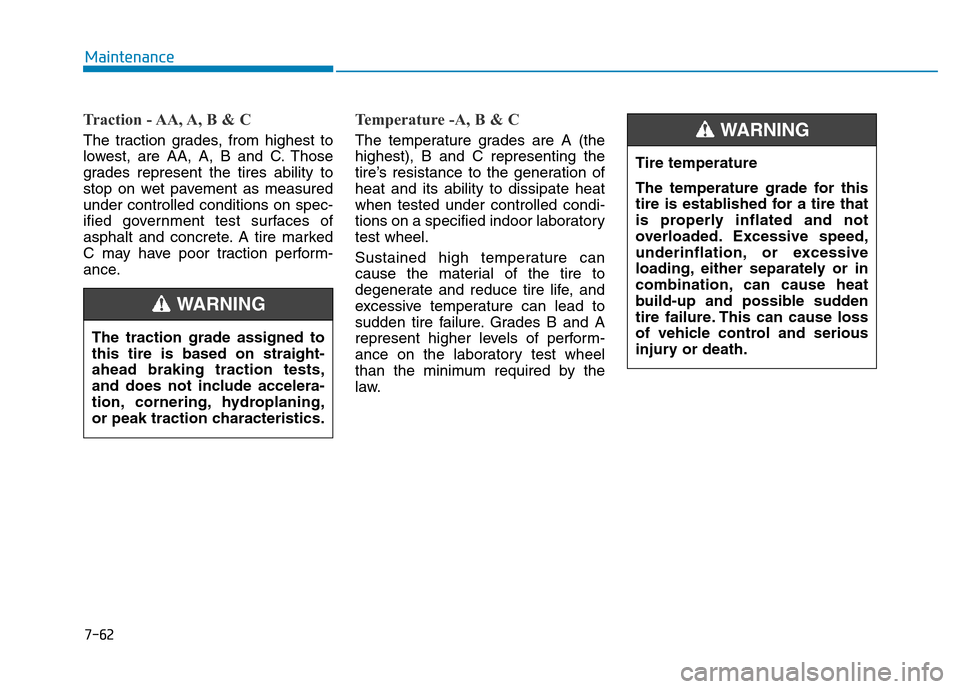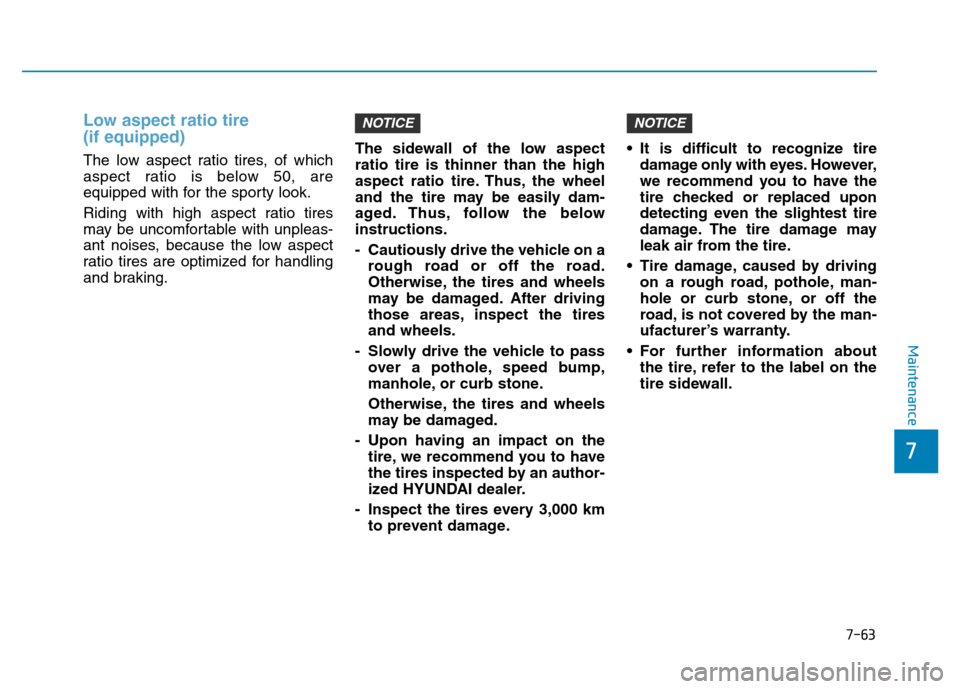Page 572 of 637

7-61
7
Maintenance
4. Tire ply composition and
material
The number of layers or plies of rub-
ber-coated fabric are in the tire. Tire
manufacturers also must indicate the
materials in the tire, which include
steel, nylon, polyester, and others.
The letter "R" means radial ply con-
struction; the letter "D" means diago-
nal or bias ply construction; and the
letter "B" means belted-bias ply con-
struction.
5. Maximum permissible infla-
tion pressure
This number is the greatest amount
of air pressure that should be put in
the tire. Do not exceed the maximum
permissible inflation pressure. Refer
to the Tire and Loading Information
label for recommended inflation
pressure.
6. Maximum load rating
This number indicates the maximum
load in kilograms and pounds that
can be carried by the tire. When
replacing the tires on the vehicle,
always use a tire that has the same
load rating as the factory installed
tire.
7. Uniform tire quality grading
Quality grades can be found where
applicable on the tire sidewall
between tread shoulder and maxi-
mum section width.
For example:
TREADWEAR 200
TRACTION AA
TEMPERATURE A
Tread wear
The tread wear grade is a compara-
tive rating based on the wear rate of
the tire when tested under controlled
conditions on a specified govern-
ment test course. For example, a tire
graded 150 would wear one-and-a-
half times (1½) as well on the gov-
ernment course as a tire graded 100.
The relative performance of tires
depends upon the actual conditions
of their use, however, and may
depart significantly from the norm
because of variations in driving
habits, service practices and differ-
ences in road characteristics and cli-
mate.
These grades are molded on the
side-walls of passenger vehicle tires.
The tires available as standard or
optional equipment on your vehicles
may vary with respect to grade.
Page 573 of 637

7-62
Maintenance
Traction - AA, A, B & C
The traction grades, from highest to
lowest, are AA, A, B and C. Those
grades represent the tires ability to
stop on wet pavement as measured
under controlled conditions on spec-
ified government test surfaces of
asphalt and concrete. A tire marked
C may have poor traction perform-
ance.
Temperature -A, B & C
The temperature grades are A (the
highest), B and C representing the
tire’s resistance to the generation of
heat and its ability to dissipate heat
when tested under controlled condi-
tions on a specified indoor laboratory
test wheel.
Sustained high temperature can
cause the material of the tire to
degenerate and reduce tire life, and
excessive temperature can lead to
sudden tire failure. Grades B and A
represent higher levels of perform-
ance on the laboratory test wheel
than the minimum required by the
law.Tire temperature
The temperature grade for this
tire is established for a tire that
is properly inflated and not
overloaded. Excessive speed,
underinflation, or excessive
loading, either separately or in
combination, can cause heat
build-up and possible sudden
tire failure. This can cause loss
of vehicle control and serious
injury or death.WARNING
The traction grade assigned to
this tire is based on straight-
ahead braking traction tests,
and does not include accelera-
tion, cornering, hydroplaning,
or peak traction characteristics.
WARNING
Page 574 of 637

7-63
7
Maintenance
Low aspect ratio tire
(if equipped)
The low aspect ratio tires, of which
aspect ratio is below 50, are
equipped with for the sporty look.
Riding with high aspect ratio tires
may be uncomfortable with unpleas-
ant noises, because the low aspect
ratio tires are optimized for handling
and braking.The sidewall of the low aspect
ratio tire is thinner than the high
aspect ratio tire. Thus, the wheel
and the tire may be easily dam-
aged. Thus, follow the below
instructions.
- Cautiously drive the vehicle on a
rough road or off the road.
Otherwise, the tires and wheels
may be damaged. After driving
those areas, inspect the tires
and wheels.
- Slowly drive the vehicle to pass
over a pothole, speed bump,
manhole, or curb stone.
Otherwise, the tires and wheels
may be damaged.
- Upon having an impact on the
tire, we recommend you to have
the tires inspected by an author-
ized HYUNDAI dealer.
- Inspect the tires every 3,000 km
to prevent damage.• It is difficult to recognize tire
damage only with eyes. However,
we recommend you to have the
tire checked or replaced upon
detecting even the slightest tire
damage. The tire damage may
leak air from the tire.
• Tire damage, caused by driving
on a rough road, pothole, man-
hole or curb stone, or off the
road, is not covered by the man-
ufacturer’s warranty.
• For further information about
the tire, refer to the label on the
tire sidewall.
NOTICENOTICE
Page 603 of 637

7-92
Maintenance
Headlamp and front fog lamp
aiming (For Europe)
Headlamp aiming
1. Inflate the tires to the specified
pressure and remove any loads
from the vehicle except the driver,
spare tire, and tools.
2. The vehicle should be placed on a
flat floor.
3. Draw vertical lines (Vertical lines
passing through respective head
lamp centers) and a horizontal line
(Horizontal line passing through
center of head lamps) on the
screen.
4. With the headlamp and battery in
normal condition, aim the head-
lamps so the brightest portion falls
on the horizontal and vertical
lines.
5. To aim the low beam left or right,
turn the driver clockwise or coun-
terclockwise. To aim the low beam
up or down, turn the driver clock-
wise or counterclockwise.
To aim the high beam up or down,
turn the driver clockwise or coun-
terclockwise.Front fog lamp aiming
The front fog lamp can be aimed as
the same manner of the headlamps
aiming.
With the front fog lamps and battery
in normal condition, aim the front fog
lamps.
To aim the front fog lamp up or down,
turn the driver clockwise or counter-
clockwise.
OAD075066L
OAD075067L
■without Headlight leveling device
■Equipped with Headlight leveling device
Page 627 of 637

8
Specifications & Consumer information
8
Specifications & Consumer information
8
Dimensions ..............................................................8-2
Engine ......................................................................8-2
Bulb wattage ...........................................................8-3
Tires and wheels ....................................................8-4
Air conditioning system ........................................8-4
Tire load and speed capacity ..............................8-5
Volume and weight ................................................8-5
Recommended lubricants and capacities ...........8-6
Recommended SAE viscosity number ..........................8-8
Vehicle identification number (VIN) ....................8-9
Vehicle certification label .....................................8-9
Tire specification and pressure label ...............8-10
Engine number .....................................................8-10
Air conditioner compressor label ......................8-11
Declaration of conformity ..................................8-11
Page 630 of 637

8-4
Specifications & Consumer information
T TI
IR
RE
ES
S
A
AN
ND
D
W
WH
HE
EE
EL
LS
S
Item Tire sizeWheel
sizeInflation pressure, bar (kPa, psi)
Wheel lug nut
torque
kgf·m (lbf·ft, N Normal load *1Maximum load
Front Rear Front Rear
Full size tire195/65 R15 6.0J X 15
2.3 (230, 33) 2.3 (230, 33) 2.3 (230, 33) 2.3 (230, 33)
11~13
(79~94, 107~127) 205/55 R16 6.5J X 16
225/45 R17 7.0J X 17
Compact spare tire
(if equipped)T125/80 D154.0T X 154.2 (420, 60)4.2 (420, 60)4.2 (420, 60)4.2 (420, 60)T125/80 D164.0T X 16
When replacing tires, use the same size originally supplied with the vehicle.
Using tires of a different size can damage the related parts or not work properly.
CAUTION
*1 : Normal load : Up to 3 persons
A AI
IR
R
C
CO
ON
ND
DI
IT
TI
IO
ON
NI
IN
NG
G
S
SY
YS
ST
TE
EM
M
ItemsWeight of Volume Classification
Refrigerant
g (oz.)
500±25 (17.6±0.88)R-1234yf (For Europe)
R-134a (Except Europe)
Compressor lubricant
g (oz.) 110±10 (3.88±0.35)PAG (FD46XG)
Contact an authorized HYUNDAI dealer for more details.
Page 636 of 637
8-10
Specifications & Consumer information
The tires supplied on your new vehi-
cle are chosen to provide the best
performance for normal driving.
The tire label located on the driver's
side center pillar gives the tire pres-
sures recommended for your vehicle.The engine number is stamped on
the engine block as shown in the
drawing.
T TI
IR
RE
E
S
SP
PE
EC
CI
IF
FI
IC
CA
AT
TI
IO
ON
N
A
AN
ND
D
P PR
RE
ES
SS
SU
UR
RE
E
L
LA
AB
BE
EL
LE EN
NG
GI
IN
NE
E
N
NU
UM
MB
BE
ER
R
OAD085010L
■Gamma 1.6 MPI
OAD085009L
■Nu 2.0 MPI
OAD085007L
OAD085007R
■Right-hand drive
■Left-hand drive
OAD085006
■U2 1.6 TCI